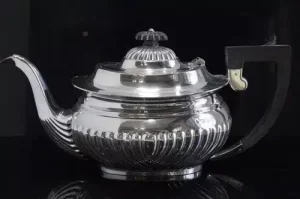Your basket is currently empty!
Silver Teaware
Silver teaware: the ultimate luxury from which to serve good tea.
 From its earliest days when tea was introduced to Britain (in 1644) and Europe when tea was a hugely expensive luxury, locked away in tea chests, the beverage has been served in silver teaware appropriate for the expense of the tea and the wealth of those people able to afford it. Silver teaware was especially in demand when afternoon tea as a social occasion was popularised by the Duchess of Bedford around 1800. Today they are beautiful to admire even as we do not recommend infusing tea in metal teapots of any kind!
From its earliest days when tea was introduced to Britain (in 1644) and Europe when tea was a hugely expensive luxury, locked away in tea chests, the beverage has been served in silver teaware appropriate for the expense of the tea and the wealth of those people able to afford it. Silver teaware was especially in demand when afternoon tea as a social occasion was popularised by the Duchess of Bedford around 1800. Today they are beautiful to admire even as we do not recommend infusing tea in metal teapots of any kind!
The earliest known English teapot was made in 1670 and is now in the Victoria and Albert Museum, London. It has a cylindrical body and a conical lid, appearing very much like a coffee pot. It was made for the British East India Company and bears its coat of arms. Teapt handles were made from wood, ivory or bone to insulate from the heat which silver conducts well. Silver teapots pre-date ceramic teapots made in England. Such teapots were imported from China and it was later that designs were copied by English potteries. To the right are two antique solid silver teapots courtesy of Russell Lane Jewellers, Warwick. The top, fluted design was made in London in 1834 with ebony fittings. A simpler style is shown below, made in Birmingham in 1875. Sheffield was another city famous for making silverware. Both teapots surely do justice to your favourite tea and the most expensive you serve!
Tea ware mainly comprises a teapot, milk jug and sugar bowl. They make very attractive sets and may be used with a tea strainer and sugar tongs for lump sugar. With all this attention to detail, good tea and use of fine China one can understand why afternoon tea is becoming increasingly popular – with or without the silver.
See our page on the history of tea.
